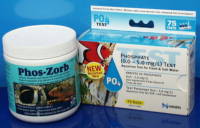
|
|

|
||||||||||
|
|||||||||
|
What's New: Recently added: article on Feeding Tropical Fish. |
|||||||||
|
|||||||||
|
|
|||||||||
Algae Control in the AquariumNot all algae in the aquarium is necessarily 'bad' - a certain amount is inevitable where there is water, light and nutrients. However, some types of algae are certainly a nuisance, if for no other reason than looking unsightly. The control or prevention of different algae types is primarily about nutrient control, and the amount of light. There are therefore some general guidelines which can be followed to help minimise algae:
The taxonomy of algae and related organisms is complex, but for the purpose of identification in the aquarium, they can be conveniently grouped into the following: "Brown algae" (diatoms)This is often the first algae to appear in a newly set-up tank, where conditions have yet to stabilise. It will often appear around the 2-12 week period, and may disappear as quickly as it arrived when the conditions stabilise after a couple of months. It is essential to minimise nutrient levels to ensure the algae disappears - avoid overfeeding and carry out the appropriate water changes, gravel and filter cleaning, etc. Limiting the light will not deter this algae, as it can grow at low lighting levels and will normally out-compete green algae under these conditions. If brown algae appears in an established tank, check nitrate and phosphate levels. Increased water changes or more thorough substrate cleaning may be necessary. Using a phosphate-adsorbing resin will also remove silicates, which are important to the growth of this algae. However, as noted above, it is essentially impossible to totally eliminate algae with this strategy alone. Due to its ability to grow at low light levels, this algae may also appear in dimly lit tanks, where old fluorescent bulbs have lost much of their output. If a problem does occur, otocinclus catfish are known to clear this algae quickly, although you may need several for larger tanks, and they can be difficult to acclimatise initially. There are some very plausible theories as to why this algae often appears in newly set up tanks and then later disappears. If the silicate (Si) to phosphate (P) ratio is high, then diatoms are likely to have a growth advantage over true algae types and Cyanobacteria. Some of the silicate may come from the tapwater, but it will also be leached from the glass of new aquaria, and potentially from silica sand/gravel substrates to some extent. Later, when this leaching has slowed, and phosphate is accumulating in the maturing tank, the Si:P ratio will change in favour of phosphate, which is likely to favour the growth of green algae instead. Green algaeA certain amount of green algae is likely to occur in any tank with sufficient lighting. It is eaten by most algae eating fish and is generally fairly easy to remove from the tank glass. Hard 'green dot' algaeThis appears as small round dots on the aquarium glass. It appears to be a normal part of planted tanks with higher light levels. Algae-eating fish will not remove this algae and manual removal requires hard scraping. Magnetic algae scrapers are usually inadequate, unless the edge of one half is used inside the tank - or use a razor blade. Hair algaeThis occurs as long greenish or grey strands. Some algae eating fish may consume it. It can be removed manually by winding around a toothbrush. Red/Brush algaeBrush or red algae can be very difficult to remove manually. It seems to be favoured in tanks with a high pH and carbonate hardness, leading some to speculate that they may be able to utilise bicarbonates as a carbon source. Limiting phosphate and silicate (either by using RO/DI water or specific adsorption resins) should deter this algae. Siamese Algae Eaters (Crossocheilus siamensis) are are often said to be the only common algae eating fish which will tackle this type of algae, although the common plec appears to eat it too. Blue-green algae/Cyanobacteria
"Blue-green algae" is not really a true algae at all, but Cyanobacteria - a group of bacteria capable of photosynthesis.
It can appear as a slimy coating in a number of different colours. It can
smother plants and may release toxins harmful to fish. It can fix nitrogen and may therefore occur in
tanks with zero or very low nitrates (but possibly high levels of other nutrients, particularly phosphate and organic wastes).
[Home] [Article Library] [Fish Index] [Tank Setups] [Forum] [Site Map] |
|||||||||||||||||||||||||||||||||||||
|
|
| The Tropical Tank Copyright © 2000-2022 Sean Evans | This website was last updated on 20th November 2022 |

